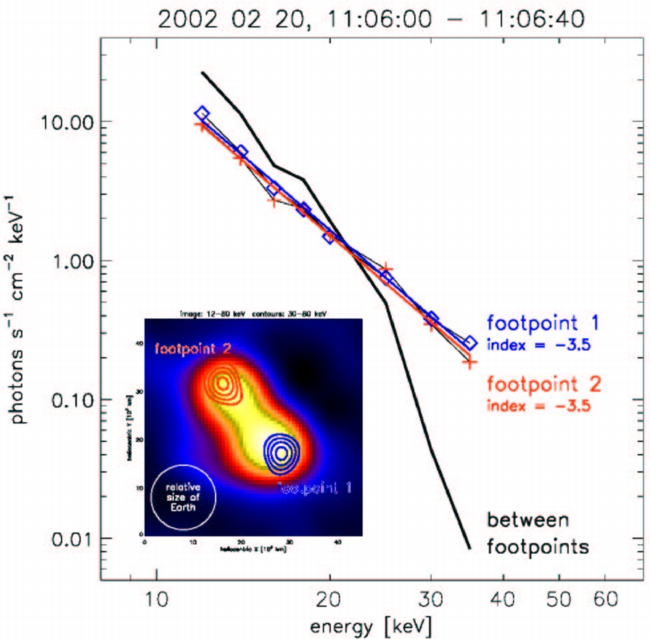
 Credit: NASA
Credit: NASA
Footprints of Fire: Dancing in the Circle of Light
The Sun is mysteriously active. Huge storms and explosions beseige the
sun's surface; giant structures larger than earth form and dissolve in the
space of days, sometimes minutes. On the most recent Sun-Earth Day,on
March 20, 2002, astronomers had a brand-new tool to use in the study of
these titanic forces: the Reuven Ramaty High-Energy Solar Spectroscopic
Imager, or RHESSI.
RHESSI is a satellite designed to study the high energy X-ray and Gamma-Ray
emissions generated by solar storms and solar flares. The image
above shows one of the first images obtained by RHESSI, of a modest
solar flare (only as powerful as a million megatons of TNT) which
occurred on February 20. The image above emphasizes the power of RHESSI: it
can spatially resolve the sources of the flare emission, and can also
measure differences in the energy spectrum of the emission too. In the
above image the inset shows a peanut-shaped flare region made up of 2 flare
"footpoints" located near the solar surface connected by a bridge of higher
emission. The solid lines represent the spectrum of energy from the
spatially distinct regions. The footpoints have similar spectra and are
probably produced by electrons accelerated to about 50% of the speed of
light; the emission between the footpoints is probably produced by gas
heated to temperatures of millions of degrees by the flare.
RHESSI was launched in February and was recently renamed in honor of Dr.
Reuven Ramaty, who died in 2001 after a long and distinguished career in
the Laboratory for High Energy Astrophysics at the NASA Goddard Space
Flight Center, Greenbelt, Md. Ramaty was a pioneer in the field of
solar-flare physics, gamma-ray astronomy and cosmic rays.
Last Week *
HEA Dictionary * Archive
* Search HEAPOW
* Education
Each week the HEASARC
brings you new, exciting and beautiful images from X-ray and Gamma ray
astronomy. Check back each week and be sure to check out the HEAPOW archive!
Page Author: Dr. Michael F.
Corcoran
Last modified March 24, 2002


